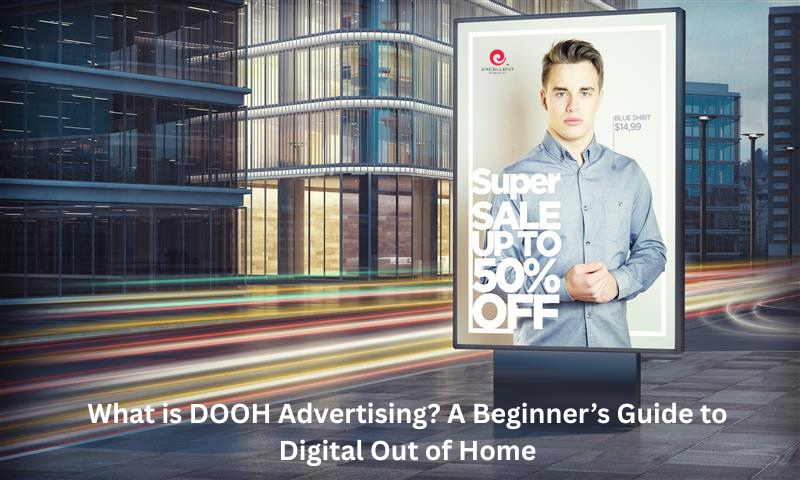In a world where consumers are constantly on the move, Digital Out of Home (DOOH) advertising is proving to be one of the most exciting evolutions in modern marketing. Gone are the days when outdoor ads were limited to static billboards. With digital screens, real-time data, and interactive elements, DOOH advertising bridges the physical and digital worlds in ways traditional media cannot.
Whether you're a brand, a marketer, or an outdoor advertising agency, understanding digital out of home is crucial for delivering high-impact campaigns in today’s fast-paced environment. In this guide, we break down the essentials of DOOH, its formats, benefits, and future trends, so you can harness its full potential.
Why DOOH Matters Today
Consumers are exposed to over 10,000 brand messages a day, yet attention is at an all-time low. In this context, DOOH advertising stands out because it’s:
- Visually dynamic
- Unskippable
- Location-based
- Always on
Unlike traditional OOH, digital OOH advertising allows brands to serve more relevant, timely, and engaging content on everything from roadside billboards to mall kiosks.
For a creative outdoor advertising strategy to succeed today, incorporating DOOH is no longer optional; it’s essential.
What Exactly Does DOOH Include?
DOOH (Digital Out of Home) includes any form of outdoor advertising that is delivered via digital screens in public spaces. These aren’t your typical printed hoardings. Think high-resolution LED displays, interactive kiosks, and motion-enabled video walls.
Here are common examples of digital out-of-home formats:
- Digital billboards on highways and main roads
- In-mall display panels and directories
- Digital kiosks in airports, railway stations, and metro stations
- LED screens on buses, taxis, and metros
- Smart street furniture (e.g., bus shelters, benches with integrated screens)
All of these share one trait: they can be updated in real-time, programmed based on audience data, and used to deliver contextual advertising.
Evolution from OOH to Programmatic DOOH
Out-of-home (OOH) advertising has been around for centuries. But digital transformation has taken this legacy medium to the next level. The key turning points in the evolution include:
- Static to Digital Screens: Early OOH formats relied on vinyl or paint. With the advent of LEDs and LCDs, brands could now deliver motion graphics and videos instead of static images.
- Time-based Scheduling: Instead of one ad for a month, DOOH introduced rotation-based slots, allowing multiple brands to share premium space.
- Programmatic DOOH: The biggest leap came with programmatic DOOH, where ad slots are bought using real-time bidding (RTB) systems, much like online ads. Campaigns can now be targeted by weather, time, location, or even live traffic data.
This shift has made digital OOH advertising smarter, more cost-effective, and performance-driven, attracting digital marketers and advertisers alike.
Key Benefits of Digital OOH Advertising
DOOH is not just flashy, it’s incredibly functional. Here are the core benefits of DOOH advertising:
- Precision Targeting: Unlike traditional OOH, DOOH allows for location, time, and audience-based targeting. You can run breakfast ads in the morning and shift to coffee promos in the evening—on the same screen.
- Real-Time Content Updates: Change creatives on the go. Update based on events, weather, or local happenings for higher relevance.
- High Engagement & Recall: Video, animation, and dynamic content grab more attention than static boards, making DOOH campaigns more memorable.
- Data-Driven Decisions: With integration into analytics platforms, brands can measure impressions, footfall impact, and campaign performance.
- Cost-Efficiency: Since ads can be rotated, shared, and optimized programmatically, the CPM (Cost per thousand impressions) for DOOH is highly competitive.
Types of DOOH Advertising Formats
Here’s a look at the most commonly used DOOH formats across urban and transit environments:
- Roadside Digital Billboards: Placed on high-traffic roads or highways, these offer maximum visibility and are perfect for mass branding campaigns.
- Retail & Mall Screens: Target shoppers near the point-of-purchase with product ads, offers, and promotions.
- Transit Hubs: Airports, metro stations, and bus stands see thousands of daily footfalls. Use DOOH here for both luxury branding and local advertising.
- Vehicle-Mounted Screens: LED panels on taxis, buses, and rickshaws reach commuters in motion and create mobile visibility.
- Interactive Touchscreens & Kiosks: Placed in malls, cinemas, or food courts, these screens engage users with motion sensors or touchscreen interfaces.
For a creative outdoor advertising campaign, using a mix of these DOOH types maximizes exposure and impact.
How DOOH Campaigns Are Purchased and Priced
With digital comes flexibility. Here’s how DOOH media buying typically works:
Direct Buying: Book specific slots or durations on a particular screen/location. Best for brand takeovers or time-sensitive promotions.
Programmatic Buying: Automated, real-time bidding for screen time based on audience triggers. Efficient and scalable for performance-driven campaigns.
Dayparting & Scheduling: Run ads at specific times of day, e.g., peak traffic hours or lunch breaks, based on when your audience is most active.
Geofencing and Retargeting: Combine DOOH with mobile tracking to deliver follow-up ads on smartphones after someone passes a DOOH screen.
Pricing depends on factors like location, screen size, display time, creative type (static vs. video), and exclusivity.
Challenges and Limitations
While powerful, digital OOH advertising is not without challenges:
- Limited Standardization: Different networks, platforms, and screen formats make DOOH less standardized than digital display ads.
- Measurement Complexity: Although evolving, measuring exact footfall-to-conversion impact still lags behind digital click metrics.
- High Initial Creative Cost: Video-based DOOH ads may require more sophisticated creatives, which can increase production budgets.
- Tech & Connectivity Issues: Remote screen management needs a strong digital infrastructure, which can be lacking in smaller towns or low-signal zones.
Working with an experienced outdoor advertising agency can help navigate these challenges more smoothly.
The Future of DOOH: AI, Programmatic & Interactivity
The DOOH space is rapidly evolving. Here's what’s shaping its future:
- AI-Powered Targeting: Artificial Intelligence will power smarter content delivery, showing ads based on crowd demographics or emotional response.
- Full Integration with Mobile: Expect more synergy between DOOH screens and smartphones for seamless omnichannel experiences.
- Neuro-DOOH: Emerging tech will allow brands to analyze how people emotionally respond to DOOH creatives through biometrics and facial recognition (ethically, of course).
- Interactive & Voice-Based DOOH: Touch-free, gesture-based screens and voice-enabled experiences will increase engagement.
As personalization and automation grow, DOOH will soon rival digital media in targeting precision and ROI.
How to Get Started with DOOH Advertising
If you're new to DOOH, here’s how to launch a successful campaign:
- Set Clear Objectives: Awareness, footfall, local targeting, or product promotion
- Identify the Right Locations: Use audience data to pick locations with high relevance.
- Invest in Quality Creatives: Motion graphics, dynamic pricing, contextual offers, DOOH thrives on visual innovation.
- Choose the Right Tech Partner or Agency: Work with a seasoned outdoor advertising agency to plan, place, and manage the campaign.
- Track & Optimize: Use metrics like impressions, dwell time, and post-campaign mobile engagement for analysis.
Platforms like Excellent Publicity offer end-to-end support, from location planning to creative execution, for impactful DOOH campaigns.
Conclusion & Next Steps
DOOH advertising is transforming how brands engage with consumers in real-world environments. With its ability to blend dynamic visuals, data-driven targeting, and programmatic efficiency, digital OOH advertising has become a must-have in the modern marketing mix.
Whether you’re a national brand or a local business, investing in DOOH opens up new ways to be seen, remembered, and acted upon. The key is to strategically combine creativity with data and partner with the right experts.
Ready to take your brand outdoors, the digital way?
Let Excellent Publicity help you create high-impact, smartly placed DOOH campaigns that deliver real results.



